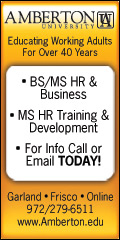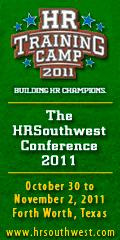HR Matters
Texas SHRM
The HRSouthwest Conference is the largest regional HR conference in the U.S. The conference offers world-renowned keynote speakers, two-and-a-half days of educational sessions, networking opportunities and so much more. Register today!
We hope to see all of the members of the SHRM-Texas State Council at our next meeting on Saturday, October 29 in Fort Worth. Log on to www.texasshrm.org for details and to register!
Prepare for your role as a volunteer leader in 2012 by attending Leadership Conference. Held in Arlington, VA, these two and a half days provide a wide variety of information, leadership development, networking and opportunity to meet with SHRM staff. Preconference sessions include the opportunity to visit Capitol Hill or attend the Membership Summit. Hotel and conference registration is open Sept. 6. Please check the link for eligible positions and registration information: www.shrm.org/conferences/leadership
Academic Initiatives is seeking certified HR professionals who are interested in becoming item writers and reviewers for the SHRM Assurance of Learning Assessment for Graduating HR Students. Item writing workshops are generally held three times a year—once in spring, summer and fall. After training, item writers are assigned two content areas to write questions. Recertification credit is available in the Leadership category (up to 10 hours) as well as the research/publishing category (1 recertification hour awarded for every 3 items that make it into the final item bank). To volunteer, please contact Nancy Woolever via e-mail at nancy.woolever@shrm.org
Innovation and Creativity are the BUZZ at DallasHR!! Expanding Membership - from Celena Baldwin and the Member Engagement Team: Our members are helping to grow and strengthen the organization to enhance the value of the HR profession! Through the new Member Referral Campaign that began in July and runs until December, members are recruiting their colleagues, business associates and friends and getting entered in super prize drawings that include an iPad, $150 gift card and a $75 prize pack! The drawing will take place at the December membership luncheon. Referring members will continue to receive a Starbucks gift card for each referral and will be entered in monthly drawings for prizes such as restaurant gift cards. The Member Engagement Team created this campaign because a vibrant and growing DallasHR means greater recognition of the Association and a wider base for networking opportunities. Great idea!
Nurturing Talent for Future Generations - from Jackie Eason and the College Relations Team:
Even seasoned HR professionals with years of practical experience must actively embrace the need for continuous learning in order to stay current in the ever changing business climate and rapidly evolving HR professional environment we must face on a daily basis. Imagine how difficult it can be for students with limited work experiences to transition from an academic focus on theory and possible applications to a new role of entry level practitioner. One exciting way that DallasHR will help bridge this gap is through a highly participative mentorship program to be launched in the 2011 fall semester. Five mentor volunteers will each be partnered with an HR student from the University of North Texas. The pilot program will be conducted from August through November with the intent to expand the program in 2012 to include college HR students throughout the entire Dallas-Ft. Worth area. This highly individualized plan involves matching specific student interest levels with specific mentor strengths related to work experiences, professional certifications and volunteer activities in the HR community. The program helps facilitate the professional development of the future HR workforce by investing quality time through valuable coaching activities with students representing the next generation of HR practitioners. It was developed by a sub-committee of the College Relations Committee including Chrissie Giles, Mariya Gavrilova and Jackie Eason. Nurturing talent for future generations!
Making a Difference for Those in Transition - Fiona Hunter's Team Shares:
DallasHR supports HR professionals in transition in a number of ways, primarily by providing forums for increased connectivity, collaboration and advice. Networking groups are held twice a month to promote increased sharing of information, contacts and building job search skills. Each meeting features a job search aspect that is tailored to HR, and facilitators are senior HR professionals who bring their expertise, talent and passion to support the group. During the last few months, topics have focused on strategy -- job search strategy as well as strategic HR -- aligning verbal and written collateral with the employer's challenges in a dynamic workplace such as top talent retention, and employee engagement. A LinkedIn group provides job leads, but also links to articles on the latest issues facing HR professionals so that they are well prepared to articulate their point of view and potential solutions in their interviews. For those in transition, we ask only a commitment to "pay it forward" when they land.
Thanks for the reminder, Fiona....pay it forward resonates with all of us!
Making a Difference in the Community with a Destiny for Change - Charlotte Leo tells us: The DallasHR Community Relations Committee has had a busy year! The group's aim is to coordinate one event each month to provide assistance to one of the four charities it supports. These are Attitudes and Attire; the North Texas Food Bank; The Salvation Army; and The Senior Source. Support has included monetary and other donations, visits to nursing homes in the community, participation in dressing days for women who are trying to re-enter the workforce, work in the food bank's warehouses, and involvement with children's events. None of this would be possible without the generosity of the members of DallasHR. Their giving spirits have made it possible to truly make an impact on the community around all of us! WOW! Touching lives in powerful ways with definite possibilities and hope! Way to go TEAM!
Women and men on corporate boards of directors appear to disagree on the importance of diversity, the need for quotas and the reasons why fewer women are represented on boards, according to research conducted by Heidrick & Struggles, a senior-level executive search and consulting firm; WomenCorporateDirectors (WCD), a global membership organization; and Boris Groysberg, a professor of business administration at the Harvard Business School. Various studies tend to paint a grim picture of board diversity. For example, as SHRM reported in May 2011, a study by the Alliance for Board Diversity (ABD) found that white men hold nearly 77 percent of board chair positions at Fortune 500 corporations, while the remaining seats are held by white women (13 percent), minority men (7 percent) and minority women (3 percent). And the 2011 Women on Boards Report, released by GovernanceMetrics International Inc. (GMI) in March 2011, revealed that, overall, women hold less than 10 percent of board positions in the 4,200 companies operating in 45 industrialized and emerging economies analyzed, a number that has changed little since the company first began measuring global board diversity in 2009.
Although nearly 60 percent of companies had at least one female director in 2011, according to GMI, just 8.5 percent had three or more women on their boards and just 2.2 percent had a female chair.
That’s why the Heidrick study, which reflects the views of 721 board members in 26 countries, provides interesting insights into some of the differences in perspectives held by male and female board directors. Among its findings: Forty-one percent of women support the use of quotas to ensure board diversity, compared to 13 percent of men. Fifty-three percent of women said they think quotas are effective for increasing board diversity, compared to 18 percent of men. Fifty-five percent of female directors said that three or more women on any board make it a more effective board. Just 16 percent of male directors agreed. And three-quarters (76 percent) of female respondents said they believe increased board diversity will help rebuild trust in boards. Less than half (42 percent) of men agreed.
"Women and men have differing points of view as to the reason why there are fewer women—both nominated and sitting on active corporate boards today," said Bonnie Gwin, vice chairman and managing partner of Heidrick & Struggles’ North American Board of Directors Practice, in a statement released Sept. 6, 2011. "About one-third of women directors globally believe that closed-off, traditional networks are the primary reason women aren't considered for director positions, whereas men believe there are fewer women currently in executive leadership roles, creating a smaller talent pipeline for entrance into the board room."
Nevertheless, in 2011, the Heidrick report found that more women and men expressed support for quotas, at 41 and 13 percent respectively, than they did in 2010, when just 25 percent of women and 1 percent of men favored the practice.
"This is a dramatic shift from last year's survey, where far fewer women and men supported quotas," said Henrietta Holsman Fore, co-chair of WCD and director of Theravance, Inc., in a statement.
Whether board quotas are effective for increasing board diversity and effectiveness worldwide remains to be seen.
"As we're learning from Norway and France, quotas, and even the threat of quotas, can be effective in increasing board diversity," Holsman Fore added. "To really work, they should be accompanied by preparatory measures, smart guidelines and implementation plans, along with databases of qualified women and corporate governance training."
Yet GMI’s report, which summarized efforts to impose quotas in various countries, noted that "Despite being the first to implement diversity quotas, Norway has experienced little upwards movement since its initial jump. From 2009 to 2011 the aggregate percentage of female directors has actually dropped slightly from 35.8 to 35.6 percent."
The National Labor Relations Board has issued a Final Rule requiring most private-sector employers to notify employees of their rights under the National Labor Relations Act by posting a notice.
Employers should begin posting the notice on Nov. 14, 2011. Copies of the notice will be available on the NLRB website and from NLRB regional offices by Oct. 1.
Similar postings of workplace rights are required under other federal workplace laws. The 11-by-17-inch notice is similar in content and design to a notice of NLRA rights that must be posted by federal contractors under a Department of Labor rule.
The notice of rights will be provided at no charge by NLRB regional offices or can be downloaded from the Board website and printed in color or black-and-white. Translated versions will be available, and must be posted at workplaces where at least 20 percent of employees are not proficient in English.
Employers must also post the notice on an Intranet or an Internet site if personnel rules and policies are customarily posted there.
Increase Your Chances of Passing the PHR/SPHR Exam
Oct. 6, 1 p.m. CST
Presenters: Jennifer Loftus, SPHR-CA, GPHR, and Elizabeth Moore, PHR
Get tips on preparing for the HR Certification Institute's PHR and SPHR exams. And, find out how the SHRM Learning System can boost your test preparation efforts. Note: This webcast does not qualify for recertification credit.
http://www.shrm.org/about/foundation/scholarships/Pages/default.aspx for additional information.
Flexible work options are significantly important to working professionals as a deciding factor when taking a job, with some even willing to give up salary to get it, according to a survey of working U.S. adults. The findings offer insight on gender and age differences as a means to surface ideas and dialogue around current workplace trends.
The survey, fielded in the second half of 2011 and sponsored by Mom Corps., a flexible staffing firm, showed that:
• More than two in five working adults (42 percent) are willing to give up some percentage of their salary for more flexibility at work; about 6 percent is the average employees are willing to relinquish.
• Perhaps surprisingly, working men (12 percent) are twice as likely as working women (6 percent) to say they would be willing to give up more than 10 percent of their salary to receive more flexibility at work.
• The 18-34 age group is up to three times more likely to give up more than 10 percent of their salary (15 percent among 18-34-year-old workers vs. 5 percent among working adults ages 35+), even though the unemployment rate for young workers is at its worst since 1948 and the highest among all age groups, according to the U.S. Bureau of Labor Statistics.
"The fact that employees of all ages are willing to give up any percentage of their salary in exchange for more flexibility over their work schedule is significant, especially given the current economic climate and record unemployment rates," said Allison O’Kelly, founder and CEO of Mom Corps. "The way a majority of corporate America works no longer aligns with the way U.S. families conduct their daily lives. Participating in some form of flexible work option allows employees to regain a modicum of work/life balance, and successful companies know that this also can yield a significant return on investment for them."
More than three in five working adults (62 percent) agreed that flexibility is one of the most important factors they consider when looking for a new job or deciding what company to work for, and one in five (21 percent) strongly agree.
"Employees are realizing they have a voice in asking for work options, and a highly volatile economic environment isn’t deterring this attitude," O’Kelly added. "The desire for workplace flexibility is strong today and will only gain popularity as the job market begins to stabilize. Employees have a responsibility to their future career growth to learn and understand their opportunities. The desire for workplace flexibility is strong today and will only gain popularity as the job market begins to stabilize."
Slightly more than half (51 percent) of 18-44-year-old working adults said they plan to look for a new job with an employer that offers flexible work options within the next three years. Nearly one in four (22 percent) working adults 45 and older plan to do the same. Organizations not offering at least some element of alternative work options need to realize that employees have enough options today that finding another job matching their lifestyle preference is no longer an insurmountable obstacle. Workplace flexibility is an increasingly important recruiting tool.
Parents are Serious about Work/Life Fit
More than four in five working parents (82 percent) feel that flexible work options would allow them to be better parents to their children, and two in five (40 percent) strongly agree. Interestingly, there is no gender difference here. So, while working mothers are often thought to be the impetus for workplace flexibility, working fathers are also seeking more balance between work and life as it relates to their children.
Organizations that extend flexibility to employees are best poised to hire and maintain top talent. And a news flash to companies: 79 percent of working mothers and 77 percent of working fathers agree they would stay with a company longer if it offered flexible work options. More than two in five working mothers (43 percent) strongly agree.
Only half of all working parents said they preferred to work a traditional 9-to-5 workday, and there was no gender difference among respondents. There were some interesting regional variances, however, with workers in the South preferring the traditional workday more so than those in the Midwest (65 percent vs. 35 percent).


